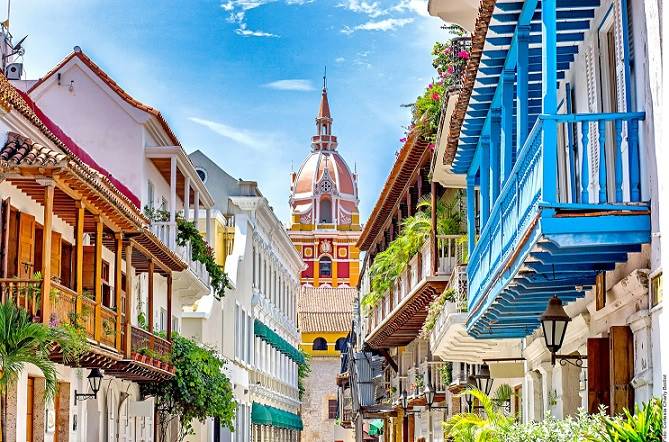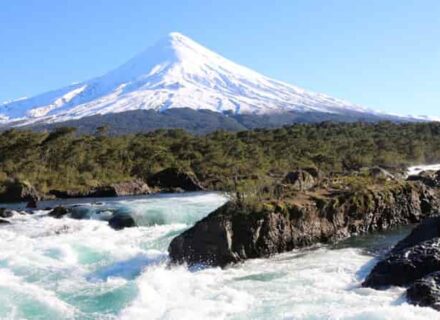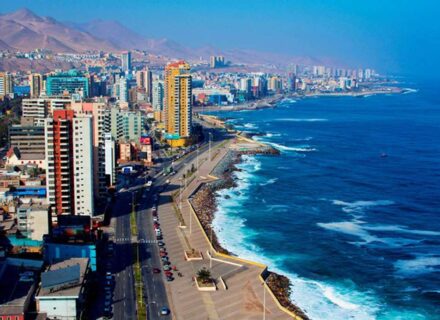When it comes to strikingly colourful colonial cities in Latin America, Cartagena is amongst the most memorable, alongside Havana in Cuba and Antigua in Guatemala. Cartagena appears to be a vast spanning mess of metropolitan madness until travellers cross the bridge and enter the tranquil sanctuary of the walled Old City. Tourists rarely venture past the old fortified walls surrounding this pocket of the city, as its beautiful rainbow of historical streets is enough to keep the senses enthralled for days on end. Each of the Old City’s buildings is an intricately designed piece of history lathered in a bright hue, from its diminutive townhouses to its opulent cathedrals. The well worn facades and flaking paint only add an antiquated charm to the character of Cartagena’s meandering streets and elderly alleys. It is a place of grand wonder where one can get lost for hours without realising that they had strayed from their path in the first place – such are the captivating qualities of its charismatic Colombian spirit.
Cartagena’s Best Spots
Given the contrast between the cheerful colonial streets of the Old Town and the chaotic traffic-strewn streets of the city’s modern reaches, the vast majority of Cartagena’s highlights are found in the former, which is split into four distinct neighbourhoods. All four contain the quintessentially colonial architecture that has made Cartagena famous but there are subtle differences, giving each a reason to visit on its own merits. Whilst the city outside the Old City walls is chaotic to say the least, this isn’t to say that it doesn’t also have its own, more metropolitan, character.
Centro
The most tourist-saturated part of the city but with good reason. A number of Cartagena’s main attractions are found here, including the architectural wonder of the St Catherine of Alexandria Cathedral, the impressive Gold Museum and the Torre del Reloj gate, whose ochre spectacle welcomes visitors into the neighbourhood’s coloquial streets. Every one of the streets in Centro is home to charming boutique shops, cosy cafes and restaurants serving delicious food of all descriptions. This area is also where many of the city’s – if not the country’s – finest hotels are located, often in the form of expertly converted old colonial homes.
There are numerous ambient squares in which to take a seat, order a Colombian coffee and watch the world drift leisurely by in front of intricately detailed buildings like the San Pedro Claver Church. One of the best things to do is wander, map free, through the narrow streets, simply following your feet as you gaze in awe at the resplendent buildings and untamed vegetation that clambers up facades and tumbles from balconies.
Top Tip
For an alternative viewpoint of the Old City’s multicoloured streets take a stroll along the top of the walls that run along its borders. The view from the walls also helps you spot the mighty spires of Cartagena’s impressive catholic architecture rising above the surrounding sea of red tiled roofs.
Getsemani
In the web of winding alleys spreading from the Holy Trinity Square at its centre, travellers can find all the hallmarks of a hip, bohemian neighbourhood in Cartagena’s Getsemani. The streets are lined with aging buildings that have taken on a new life through their blazing colours and impressively detailed murals. Home to a number of international eateries and local taverns, Getsemani possesses the laid-back Latin charm that has been lost over time in so many other Colombian barrios.
As the sun begins to set over Cartagena’s colourful colonial streets and walkways, the Holy Trinity Square at the barrio’s heart becomes a hub of social activity as both local families and tourists flock here to meet friends, sink a few cold beers and visit the street food stalls to devour a stuffed arepa or two. It is a Latin American experience that will live long in the memory.
Top Tip
At the northwestern edge of Getsemani, travellers can find Parque del Centenario, whose dense foliage not only offers some respite from the heat of the Caribbean sun but is also home to a number of tropical creatures. An unlikely wildlife spotting opportunity, this small urban park is the adopted habitat of iguanas, monkeys and sloths.
San Diego & La Manuta
Perhaps the most peaceful of the neighbourhoods in Cartagena’s walled city, San Diego is a pleasant collection of easy going streets bursting with the city’s textbook spectrum of colours and sitting atop the historic walls is the city’s most popular spot from which to watch the sun setting over the Caribbean Sea. It is the place to head for anyone looking to take life a little slower and leisurely absorb their surroundings.
San Diego is also the place to find some of Cartagena’s nicest restaurants, a number of which can be found in the vicinity of the charming Plaza de San Diego – the perfect place to spend a quiet afternoon. One of the main draws is the craft market, Las Bovedas, which is located under the northeastern corner of the Old City’s walls. Even if you aren’t interested in browsing the market’s trinkets, the architecture of this former prison is a draw in itself.
La Manuta is undoubtedly Cartagena’s Old Town’s least captivating barrio, with more bland concrete architecture than all of the others combined.
Top Tip
Those interested in taking an authentic piece of Cartagena home with them should browse the chaotic Anticuario el Arcon, a quirky antique shop located in a small colonial town house. The walls and floors are bestrewn with a mish mash of artefacts from all over the Americas, from hand-drawn antique maps to majestically carved chests of drawers.
Outside the Old City
Bigger, crazier, grittier. A trip outside the sanctuary of Cartagena’s Old City walls will introduce you to a more authentic look at everyday life in urban Colombia. Those that really wish to dive into the deep end of the chaos needn’t look any further than the whirr of activity that is Mercado de Bazurto. Selling produce from across the whole of Colombia, including fresh fruit and varied seafood caught that very morning. It has almost as much of a reputation for pickpocketing as it does for fresh produce so mind your wallet when wandering between the stalls.
Those that would rather avoid such whirlwind experiences can casually lap up the history of the San Felipe de Barajas Castle just across the water from the Old Town. An impressive hilltop fortress that served as a vital defence against Caribbean pirates during the 16th and 17th centuries, it boasts an extensive tunnel system that visitors can explore at their own free will. A visit to the castle also offers excellent views over the tiled rooftops of the buildings it once protected from the opposite side of the water.
Top Tip
If you decide to venture outside Cartagena’s Old Town and find it all a tad overwhelming you could always take a quick trip to Playa Blanca just to the city’s south. It is a surprisingly beautiful spot considering its proximity to the city, with all the features one would expect from a Caribbean beach.
Food & Drink in Cartegena
Cartagena’s restaurant scene caters for those wishing to sample local cuisine as well as those who prefer a more homely dish to be placed in front of them. The Old City is rife with traditional Colombian eateries, restaurants with more of an international focus and, due to the city’s history and geography, a handful of authentic Caribbean options.
Colombian
Colombian food is a relatively undiscovered culinary phenomenon. Whilst meals can occasionally lack in mouth-watering flavour, they always make up for it in terms of portion size. Hearty classics include chicharron – a deep fried pork rind which is as delicious as it is unhealthy – and ajiaco – a chicken, corn and potato soup served with rice, avocado and capers. However the most filling meal of all comes in the form of bandeja paisa, a platter of sausages, beans, rice, avocado, eggs, plantain and goodness knows what else that would put any full English breakfast to shame.
To try authentic street food head to Getsemani’s Holy Trinity Square in the evening and get your hands on an arepa stuffed with your choice of fillings and topped with soft cheese. The ideal way to start an evening out in Cartagena.
International
Despite the Old City itself having an unquestionably Latin atmosphere, foodies can find everything here from classic Italian pizzerias to flavoursome Indonesian noodle dishes to grandiose gastronomic experiences. The old town is also home to a number of boutique cafes that wouldn’t be out of place in any of Europe’s trendiest neighbourhoods.
As with much of South America, the tourist friendly spots of the city offer up just about any cuisine that you can imagine. Unlike most of South America, the international food in Cartagena is typically of a very good standard.
Caribbean
There is an air of Caribbean flair reverberating about the streets of Cartagena, not least because of the iconic Palenqueras, whose vibrant dresses, plentiful fruit bowls and beaming smiles have become a symbol of the city. This influence has also had an effect on the food scene here, with passionate Caribbean flavours available across much of the city.
West Indian inspired favourites in Cartagena tend to have a strong focus on seafood, as one would expect, with restaurants serving expertly spiced fish and shellfish. Exotic fruits fresh from the Colombian countryside also feature heavily, sometimes as a dessert, sometimes in the form of a cocktail.
Coffee
You can’t talk about drinks in Colombia without mentioning coffee – the beverage for which the country has become renowned. Despite being the third biggest producer of coffee on the planet – after Brazil and Vietnam – Colombians will insist that when it comes to quality nothing surpases their coffee.
Coffee houses are extremely common throughout Cartagena, from casual local hangouts to deluxe establishments serving the popular drink in all of its possible forms – from cappuccinos and lattes to the more Colombian cafe con leche. For those seeking the most common form of Colombian coffee, tinto is the one for you. Served on the street in small portions, no milk and laden with sugar. It’s not for everyone but sure to give you a buzz.
Getting around Cartagena
If travelling from one part of the Old City to another there is no need to use transport of any kind, as walking is not only easy – the city is flat and not much more than a kilometre from end to end – but it also provides the opportunity to take in Cartagena’s charismatic ambience as you walk, discovering nooks and crannies that would otherwise have gone unnoticed.
When travelling outside the Old City walls, public buses travel to all corners of the city and beyond with relatively high frequency.
Alternative things to do in and around Cartagena
The comparatively diminutive pocket of history that is the Old City of Cartagena tends to be the central focus of any trip to this city that seamlessly marries manic Latin passion with colourful Caribbean charm. However, just outside the city’s metropolitan reaches are a number of activities that are sure to intrigue and thrill those that wish to experience something other than quintessential colonial charm.
Taking a day trip to the gorgeous Rosario Islands
Swap the city for a slice of Caribbean paradise for the day with a trip to the Rosario Islands. These postcard-perfect islands exemplify the best of Colombia’s Caribbean side, with pearl white sands, crystal clear waters and some of the freshest seafood in the country. Once here, you can snorkel with tropical sea life, explore the islands’ forested interiors or simply recline and soak up the sun rays.
These white sanded, sapphire watered islets are found just 100km from Cartagena’s docks – roughly one hour’s journey by speedboat. If you find yourself reluctant to leave at the end of the day, don’t worry – there are a selection of hotels on the islands, meaning you can stay until you’ve had your fill of pristine paradise.
Visiting the historic village of San Basilio de Palenque
Those that wish to delve deeper into the different histories surrounding Cartagena cannot miss out on the opportunity to visit San Basilio de Palenque – undoubtedly one of the most significant villages in the region. During the 17th century, Cartagena became a vital port in the slave trade, meaning thousands were transported from Africa to the city to be sold into slavery. Many of these slaves escaped and sought refuge in the surrounding hills, creating communities in walled villages called ‘palenques’.
The San Basilio de Palenque was the only village to withstand Spanish raids, as well as carrying out rescue missions to save others in their situation, thus becoming the first free Africans in the Americas. Due to their brave resilience, those who inhabit the village today are not only descendents of the original vigilantes but have also retained all of their traditions, including an utterly distinct language, which cannot be found elsewhere.
A visit here not only allows one to appreciate the heroic exploits of its original inhabitants but also provides an experience of life within a community that does not exist elsewhere. Interestingly, San Basilio de Palenque is very village where Cartagena’s famous Palenqueras originate from.
Navigating your way through the mangroves at La Boquilla
Step aboard a traditional wooden canoe with a local boatman and venture through the maze of natural tunnels created by low hanging mangrove trees in the swamps of La Boquilla. Trips through this water system allow travellers to witness the natural flora and fauna up close and experience the fascinating ways of life adopted by the area’s inhabitants, watching them wade waist-deep into the water as they catch fish and crabs in the same way that they have for 250 years.
A trip to La Boquilla is an experience that allows travellers to witness a pocket of Colombia that has remained relatively untouched by the tourism industry, meaning a more authentically traditional Afro-Caribbean influenced encounter. Those who are willing to get wet can even try their hand at some of the traditional fishing methods used by La Boquilla’s residents.
Receiving a spa treatment in a volcano
Just to the north of Cartagena lies an opportunity that doesn’t present itself too often in the form of El Totumo, a small volcano on the shores of a lake. Closer in resemblance to a large termite mound than a lava spouting mountain, El Totumo draws travellers to its dinky peak for one specific reason – the chance to soak in its naturally occurring mud pool.
After climbing the rickety wooden staircase to the top of the volcano, travellers will dip into the “healing” mud bath alongside other tourists seeking silky-smooth skin. It can get quite cosy in the mud bath so be prepared to get up close and personal with complete strangers. You may even be offered a massage whilst bathing, completing the somewhat bizarre natural spa experience, before descending another set of rickety steps whilst coated in volcanic soil and washing off in the lake. Whether you like spa treatments or not, this is a unique experience that you won’t forget any time soon.
Drink like a local outside Tienda las Tablitas
There are a number of ramshackle shops and bars in Cartagena that sit amongst the comparatively regal colonial architecture like a happy reminder of the city’s Caribbean geography. Tienda las Tablitas may well be the best example of this.
The small wooden shack, complete with corrugated iron roof and faded electric blue paint, emits a strong impression of the jubilant, care-free attitude that the Caribbean is renowned for across the globe. Somewhere between a cornershop and a local watering hole, Tienda las Tablitas is the ultimate place to chat with the local families that converge on this charming establishment every evening whilst sat on plastic chairs on the street, sipping on an ice cold Club Colombia. Perfect.



